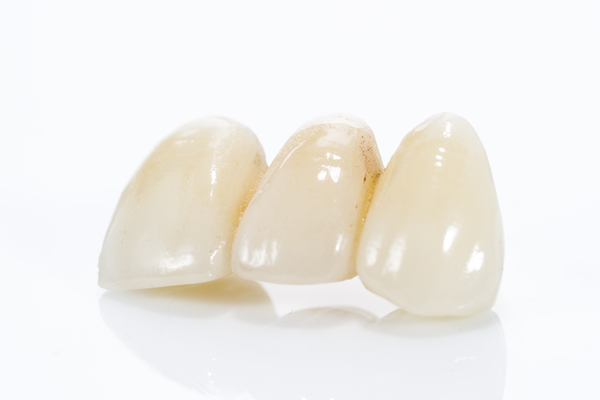Implant Bridges as a Restorative Option

An implant bridge is a dental restoration that closes up the gap made by one or more missing teeth. It is a restorative option that dentists recommend to patients with a gap that is flanked by natural teeth, preferably on either side of said gap.
How does it work?
Like a traditional bridge, an implant bridge also consists of two parts. The first is the pontic or the artificial tooth. It consists of a series of dental crowns that are fused together. This is the part of the bridge that rests in the gap, where it assumes the functions of the missing tooth or teeth. The pontic is what the patient uses to bite, chew, form words or smile.
The second part of the bridge is the abutment, which takes the form of an implant-supported crown. With conventional bridges, the crowns that support the pontics are placed over the natural teeth that are adjacent to the gap, on either side. With an implant bridge, the crown, or abutment, attaches to a dental implant.
You may be wondering why a dentist might recommend an implant-supported bridge overfilling the gap with individual implant-supported crowns. Keep going to find out when and why a dentist would recommend an implant bridge.
When is an implant bridge a good idea?
Take the case of a patient that has a gap left by five missing front teeth on the upper jaw. A dentist will examine the individual and make one of two recommendations. They may recommend five implant-supported crowns. Or they may decide to place two implant crowns on both ends of the gap and fill the remaining gap with a bridge with three fused crowns. The dentist will take this approach if:
1. The patient lacks enough bone mass to hold one implant for each missing tooth
When a dentist evaluates a prospective candidate for dental implants, they check if their patient has enough jawbone to hold an implant. A person with five contiguous missing teeth will likely lose more bone mass at the center of the gap than at its edges, which are bordered by natural teeth that stimulate bone growth. In such a scenario, the dentist will:
- Place the dental implants at the edges of the gap, where the jawbone is denser
- Attach dental crowns to the implant
- Place the bridge and attach it to the implant-supported crowns
2. The patient has more than one missing teeth
There is no need to make an implant bridge for a single lost tooth. However, implant bridges become an option if the person needs to replace multiple teeth.
3. The patient is likely to place too much pressure on multiple implants
Dentists also evaluate a patient’s bite before they clear them for dental implants. During the evaluation, a dentist may find that their patient is likely to place too much pressure on multiple implants, which would drastically improve the risk of implant failure.
Instead of replacing five missing teeth with five implant-supported crowns, the dentist will place two implant crowns and use them as supports for a bridge with three crowns. This will minimize the amount of pressure that the patient applies to the jawbone as they bite down.
Do you need a smile makeover? Our dentist is happy to help
Missing teeth can make life a little hard. You become more cautious as you chew, making sure to adjust your bite because of the missing teeth.
Our dentist wants to give you back that little sliver of freedom that your missing teeth took with them. Set up an appointment today.
Let's get started…
Request an appointment here: https://www.northside-dentalcare.com or call Northside Dental Care, PC at (978) 206-7077 for an appointment in our Peabody office.
Check out what others are saying about our services on Yelp: Read our Yelp reviews.
Recent Posts
A family dentist is an excellent choice for the entire family. If you are a parent, you know that the health of you, your children, and your partner are a top priority. Often, many parents do not schedule their dental appointments because scheduling conflicts with their children’s. This problem goes away when you find your…
Your family dentist can help you regain your dental health. Dental damage or tooth loss can make eating and speaking difficult. Finding the right dental restoration is possible. Here are the details about the restoration options that you can get from your family dentist.Bacteria eat away the enamel layer of teeth, which results in cavities.…
As you age, your teeth face challenges from numerous issues. Daily wear from chewing food or stress-related grinding, gum problems from bacteria build-up, and tooth damage from the foods and drinks you consume all play a role in the deterioration of your smile.You and your dentist share a common goal: caring for and preserving your…
Taking care of your family's dental health is important to help maintain your and your children's overall health and well-being. Regular visits to a family dentist can help identify and treat dental problems before they become more serious and require more intensive care. However, finding the right family dentist can be daunting, especially if you…


